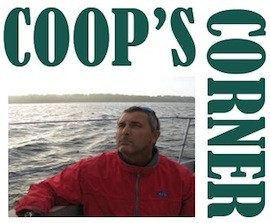
The scene: A lovely Sunday afternoon on our favorite body of water…steering our boat upwind. The sails are trimmed just so, the boat is at about 12-15 degrees of heel, feels great and you know it is going “fast” without looking at the TV on the binnacle. Quick question: How many disciplines of science and math are being employed in this scene? Answer: Lots.
Hydrodynamics, including displacement volume, lift from a keel (more correctly reported as reduced leeway), wave length, drag (both shape-induced and laminar drag; the latter from rolled-on bottom paint, not wet-sanded, aerodynamics including lift and drag from the sails, and parasitic drag from the standing rigging, the halyard stowed on the front of the mast, the spreaders, lifelines, the surface of the hull exposed to the wind, the cabin top, dodger and bimini.
The whole sailing operation is one huge force vector. Yeah, OK. So?…Pass the sunscreen…
The disciplines used in “just” sailing use many of the subjects that kids, especially high school kids, wrestle with at school. If you concede that we all learn more effectively and more thoroughly when engaged in the lesson, then making the learning experience more engaging for kids must help them understand and retain the meat of the lessons they will need over their lifetime.
My high school life was lived within sight of Sydney Harbor or the Tasman Sea, depending on which room I was in. I was, as measured by the quantifiable standards of the day, a pretty dull student, barely scraping by. The paragraphs above are all things I have learned since leaving school in 1970. For years I have maintained that sailing is a great activity with which to demonstrate, and give practical application to, the subjects that high school kids have to study and really know about.
I have learned about geography, oceanography, meteorology, economics, history and people through sailing. Not to mention engineering, strengths of materials, navigation, and perhaps a dozen more skills that are useful in all walks of life.
From 1993 – ‘96 I ran a non-profit called Sailing As Integrated Learning (SAIL). The idea was to use interesting sailing adventures to expose kids to all the disciplines in a way that was fun, interesting and compatible with their lessons. My idea was an expansion of what the BOC Race (now the Velux Five Oceans) was doing.
One of the projects I did was taking a Quest 30 from Newport, RI to Plymouth, England for the owner to race back in the O.S.T.A.R (Observer Singlehanded Transatlantic Race). Using very rudimentary (by today’s standards) satellite comms, I was able to communicate with about half a dozen middle schools. I was later told that when I went off the air for a couple of days due to engine (thus electric) problems, the kids would come to school at 0700 rather than the required 0800 in order to track things like the ice reports from the Canadian Coast Guard. Their teacher also told me he had never seen his kids so excited at being in school while learning about latitude and longitude, ocean currents, ice formation, flow and melt, and weather.
This idea of using sailing as an educational tool is spreading slowly but surely. The Volvo Ocean Race guys have it, the AC World Series has it and the Big Match has it. The French have it in all their solo races, including the Vendée Globe. A few months ago, US Sailing announced their REACH program. This program features an 11-module curriculum created to directly match the curriculum that middle school kids study. The idea is that summer sailing program instructors can integrate a module into a day’s instruction when the conditions are not suitable for sailing.
Quite apart from the hard sciences cited above, sailing instructs one in many life skills. Thought process, clear thinking and communication, physical activity, ability to overcome adversity, a degree of manual skill and dexterity, pushing one’s own boundaries of anxiety/fear, developing judgment, working as a team, responsibility for equipment and a dozen more.
The Storm Trysail Foundation has recently introduced their Expeditions Projects. The first one is Expeditions Projects: O.S.T.A.R., following Boston sailor Jonathan Green as he sails to Plymouth, England then races back in the OS.T.A.R. Jonathan sends daily updates on what is going on, and these are translated into non-sailing lingo and expanded upon for the subscribers following the project’s progress.
As is often the case, the formal organizing of something comes along after the basic idea is out of the slip. Science, Technology Engineering and Math (STEM) is the acronym du jour in educational circles, the idea being that the U.S. needs to lift its game in these hard disciplines. Well, sailing has been doing this since the first caveman put a bearskin on a stick to make his log go faster than his pursuers.
So, next time you are out sailing with your kids, think back to basics and try to connect some of the disciplines you know about, perhaps without even realizing it, to sailing and to what the kids are up to at school.
Australian born, Joe ‘Coop’ Cooper stayed in the US after the 1980 America’s Cup where he was the boat captain and sailed as Grinder/ Sewer-man on Australia. His whole career has focused on sailing, especially the short-handed aspects of it. He lives in Middletown, RI where he coaches, consults and writes on his blog, joecoopersailing.com, when not paying attention to his wife, teenage son, dog, two cats and several, mainly small, boats.




